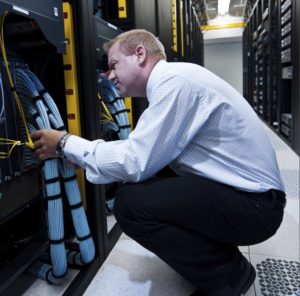
Learn more about the basics of backbone cabling.
Cabling doesn’t receive as much attention as other parts of the infrastructure, but it’s an integral part of your network. It’s essential to choose your cabling wisely when building your data center and designing your network infrastructure. However, this is impossible if you are unfamiliar with different cables and their components.
Two of the most common cabling methods are backbone and horizontal cabling. This article will take you through what goes into backbone cabling.
What is Backbone Cabling?
Backbone cabling is a set of cables used to connect networks. It can be installed between entrance facilities, telecommunication rooms, and equipment rooms.
These cables help deliver communication between one floor of the same building to another or different rooms on the same floor. Backbone cables control traffic problems and serve as an effective troubleshooting tool if things go awry.
Components of Backbone Cabling
A backbone cable consists of the following parts.
Cable pathways
These are the routing channels for the cabling process. They include floor penetrations, shafts, raceways, or conduits. Cable pathways are designed to allow you to efficiently run cables through walls and ceilings without damaging existing infrastructure.
Connecting hardware
This includes connectors, cabling, and hardware, such as patch panels. Connecting hardware allows information to be transmitted along a network, which is an integral part of networking. Each network device connects to another network device by using connecting hardware.
Wiring
There are many types of wires in backbone cabling, but the main ones are copper and fiber. Copper wiring is typically composed of copper-wire twisted pairs that send digital pulses at high frequencies. On the other hand, fiber wiring consists of a thin glass filament wrapped by multiple layers of protection.
Each wiring system has its pros and cons. Copper wiring is easy to install, durable, affordable, and sturdy enough to handle large amounts of data. However, it might not be efficient in transmitting data over long distances.
Fiber optic is suitable for installation on any computer hardware. Because it is not affected by electromagnetic interference, this wiring is reliable for transmitting data over long distances. Its speed and reliability increase network security and make fiber-optic cables ideal for communication equipment.
Trust Guidance From the Professionals
While backbone cabling can seem like an overly complex topic, it’s much simpler than you might think. The system breaks down to cable pathways, connecting hardware, and wiring. Knowing what goes into your cabling system enables you to use them optimally. FiberPlus can help you understand the best cabling for your property.
Get in Touch with FiberPlus
FiberPlus has been providing data communication solutions for over 25 years in the Mid Atlantic Region for a number of different markets. What began as a cable installation company for Local Area Networks has grown into a leading provider of innovative technology solutions improving the way our customers communicate and keeping them secure. Our solutions now include:
- Structured Cabling (Fiberoptic, Copper and Coax for inside and outside plant networks)
- Electronic Security Systems (Access Control & CCTV Solutions)
- Wireless Access Point installations
- Public Safety DAS – Emergency Call Stations
- Audio/Video Services (Intercoms and Display Monitors)
- Support Services
- Specialty Systems
- Design/Build Services
- UL2050 Certifications and installations for Secure Spaces
FiberPlus promises the communities in which we serve that we will continue to expand and evolve as new technology is introduced within the telecommunications industry.